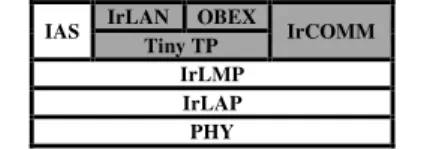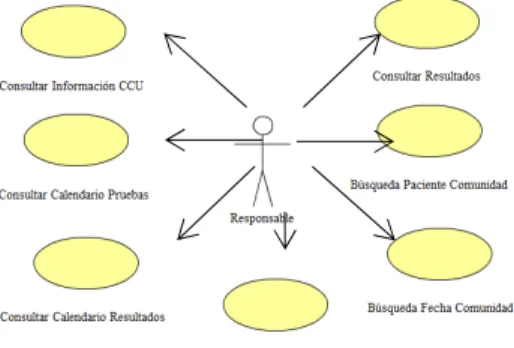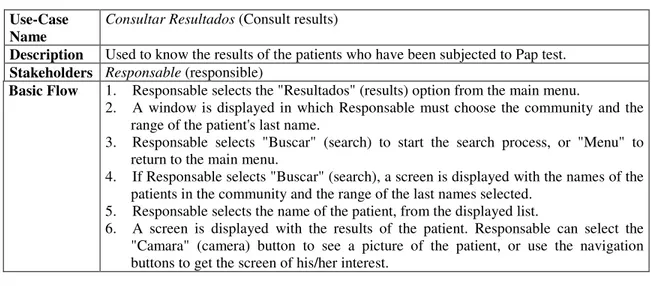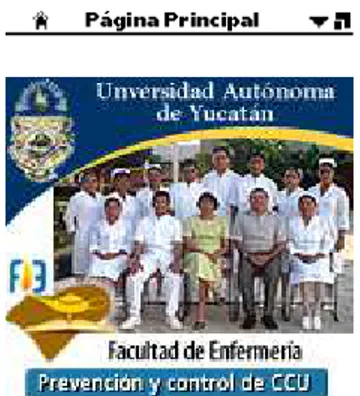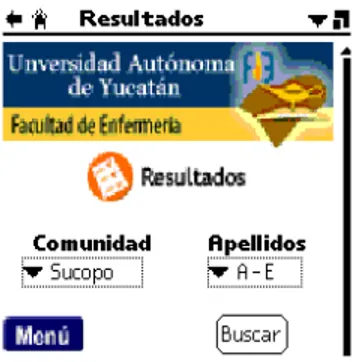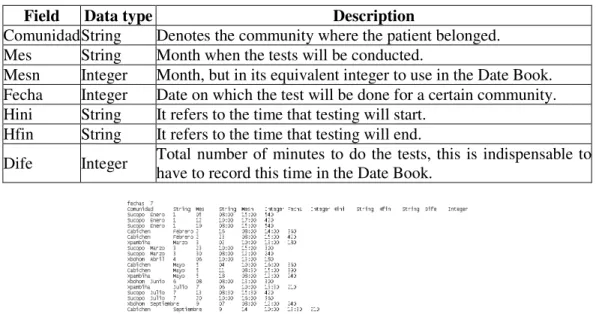DOI : 10.5121/ijdps.2011.2412 133
Victor Chi
1, Lizzie Narváez
1, Erika Llanes
1, Janine Narváez
2and Maximiliano
Canché
11
Universidad Autónoma de Yucatán, Unidad Multidisciplinaria Tizimín,
2Instituto Tecnológico de Tizimín,
Tizimín, Yucatán, México
1{victor.chi,lendiaz,lcastro,caneuan}@uady.mx,
2janinenarvaez@hotmail.com
A
BSTRACTThis paper presents the development of a system to prevent and control Cervical Cancer. This system runs on a handheld using infrared technology from a service point to make the current process more efficient for the staff responsible for carrying out diagnostic tests, as well as for doctors from health clinics in communities belonging to the city of Tizimín, Yucatan, Mexico.
K
EYWORDSIrDA Technology, WideRay Jack, Cervical Cancer.
1.
I
NTRODUCTIONThe development of the technological capabilities of mobile handhelds (phones and PDAs) has taken place over the past few years [1], with the proliferation of those around us.
The digital division between industrial cities and the developing world represents an opportunity for many universities to build sustainable models for the development of their students and their growth.
The sophisticated development of communication has led us to share data between electronic devices (calling it Wireless Communication) using as an intermediary for the exchange of data one of many current technologies: IrDA Transceivers (Infra Red Data Association Transmitter Receiver), Bluetooth or 802.11 Protocol.
In this development, keeping in mind the resources at our disposal, infrared technology was used. These devices have the ability to transmit and receive data without using a serial cable between them, instead they use a wireless data connection using infrared light. The IrDA is inexpensive, capable of exchanging data in both directions and at speeds ranging from 9600 bps to 4 Mbps.
134 part of its functions, has to perform various activities in health promotion in rural communities around Tizimín.
One of the many activities of CDD staff is moving to those communities to test for Cervical Cancer in order to prevent and control it. Each community has a small health clinic, where the CDD staff go to perform this kind of test as support, so that along with the doctor, they may respond better to the welfare of the people in the communities. Due to fact that the health clinics of the communities do not have the equipment to analyze these tests, CDD staff, after obtaining the samples, analyzes them in the HU of the UADY in Tizimín, and at later dates, they go back to the communities for delivery of results.
The current operating procedure for the carrying out of tests and/or delivery of results is as follows: at the beginning of each year, the CDD staff prepare a calendar of activities for testing and delivering the results; leaflets are produced, which include this information as well as the preconditions to be met by the women in the community before it is done; for the delivery of the leaflets, the CDD staff travel to the community. With regard to the analysis of results, after applying the tests, a form is manually filled out for each of the patients. On the day of the delivery of results all this documentation has to be loaded, so the CDD staff or the doctor of the health clinic can provide the results to the patients. This sometimes means records are misplaced amongst the documentation for different communities, or when the CDD staff get to the community, they notice that the documentation is not complete, and consequently some patients do not receive their results on time.
The completion of these tests is of great importance since it has been shown that in the state of Yucatan there are 30.4 deaths caused by Cervical Cancer per 100,000 women aged 25 years or more (statistics from the National Population Council, CONAPO). In addition, women living in rural areas of the state had a 3.07 higher risk of death from this cancer, compared with urban residents.
For all these reasons, the Cervical Cancer prevention program’s goal is to reduce the high frequency of this cancer and deaths caused by this disease. It is therefore hoped that the system presented here, might provide technical reports in order to systematize the actions in the prevention and control of this cancer, and to track and control it in rural communities in the eastern region of the state of Yucatan.
Based on the above, a system was developed using infrared wireless technology in an issuer of WideRay Jack content, so the CDD staff or the doctor in the communities can get all the information they need while avoiding printed documentation, making the process more efficient. This will be achieved by placing a Wideray device in the CDD of the HU, in which only the department staff and doctors will have access to all information stored on it.
With the development of this system, patients will wait less time in health clinics to get their results. Also, due to all information is stored on the Wideray device, once it is downloaded to the doctor or CDD staff's PDA, the results will be delivered to patients in a timely manner.
135 software mobile publisher and platform provider Handango Inc. WideRay are joining strength to produce mobile kiosks that will offer Handago's catalog of 20,000 applications for devices such as personal digital assistants (PDAs). On the other hand, the content in [4] shows us a very important point: WLAN hotspots are cool for internet access. The content in [5] explains how in Peru, the project PREVEN conducted a field study in 20 cities of the country in which data on sexual behavior were collected using PDA. There was a good correlation between the responses on paper and PDA responses. The project suggested that the PDA was a viable option to the paper formats for field data collection in a developing country. In [6] we can appreciate the use of WideRay applied to the field of education. In [7] a case study of the use of Wideray, PDA's and MTN Cellular Network is presented. In [8] a mobile catalogue of rules of generation of the CFE (the main electricity company in Mexico) is presented, which was developed with the use of WideRay.
2.
I
RDA
T
ECHNOLOGYInfrared Data Association (IrDA) defines a physical standard of transmission and reception of infrared data, established in 1993 by HP, IBM, Sharp and others.
This technology is based on light rays that move in the infrared spectrum. IrDA standards support a broad range of electrical, computer and communication devices, allows bidirectional communication between two peers at speeds ranging from 9600 bps to 4 Mbps. This technology is found in many laptops, PDAs and mobile phones. The FIR (Fast Infrared) is under study, with theoretical speeds of up to 16 Mbps, [9]. IrDA currently exists in millions of devices.
It is based on visible light, being a secure way of communication. The direct infrared connection is point to point, typically one to one communication, is not subject to rules, it requires line of vision and is also a safe way to transmit and receive data, so that it is possible to access a LAN with such confidence like using a cable. The radio frequency is not safe due to the fact that it can penetrate walls, it is subject to uncontrolled interference, and it is typically higher in power than the direct infrared [10]. IrDA defines an organization in layers as shown in figure 1.
IAS IrLAN OBEX IrCOMM Tiny TP
IrLMP IrLAP PHY
Figure 1. IrDA Layers Organization.
In addition, any device which seeks the agreement of IrDA protocols must meet the requirements (white background in figure 1); however it can skip some or all of the optional protocols (dark background in figure 1). This differentiation allows developers to choose lighter and less expensive designs, which can also accommodate the most demanding requirements without having to exit the IrDA standard
3.
W
IDER
AYJ
ACK136 centralized management of all content. In short, it is a system for users with a PDA and other sectors such as education, medicine, among others.
WideRay Jack Service Point is a solution for delivering local content to mobile devices over Bluetooth or IrDA. Jacks have been deployed in real end user environment, such as shopping malls and sports facilities.
WideRay Jacks are portable and can be wall-mounted in high-traffic areas and accessed by multiple PDA users. These jacks can support simultaneous synching of multiple PDA’s within a 15 foot range [7].
WideRay is an equipment and integrated platform provider focused on the high-speed free-spectrum on-location wireless data services market. WideRay has developed a single-box architecture for deploying centrally managed, high-speed, low-cost wireless data services in scale, using both infrared and short-range RF for connecting with mobile devices. WideRay's back-end architecture is based on GSM/GPRS for global, always-on support [11].
In the development of this system the WideRay Platform with a Jack Service Point was used. The model that we use supports infrared beaming. Using the jack (figure 2) involves:
• Turning on our handheld device and pointing it at the Jack.
• Downloading the WideRay installer (The installer application allows us to download the WideRay browser and content. The WideRay browser works like a web browser). • Clicking buttons, links, images, and pulldown menus to navigate through content. • Selecting the forward and back buttons to review pages. Selecting the home icon to
return to the front page.
• Once downloaded, the WideRay browser can be used to access Jack anywhere. • Selecting the WideRay icon to launch the browser.
• Pointing it at the Jack and downloading new information (We can stand up to 3 feet away from the Jack).
Figure 2. Download the Application.
Some uses for WideRay Jack are: retail, trade show/conference, sports/entertainment venue, education, healthcare and information kiosks among others.
The WideRay Browser application takes up approximately 100 kb of storage space on your handheld. The size of the content can vary; a typical content piece is 80 kb, (it takes approximately 10 seconds to receive the WideRay Browser and approximately 10 seconds to receive content). The Jack will automatically detect that the program is open and will immediately send the content [12].
4.
C
ERVICALC
ANCER137 Treatment consists of surgery (including local excision) in early stages and chemotherapy and radiotherapy in advanced stages of the disease.
Pap smear screening can identify potentially precancerous changes. Treatment of high grade changes can prevent the development of cancer. In developed countries, the widespread use of cervical screening programs has reduced the incidence of invasive cervical cancer by 50% or more. Human papillomavirus (HPV) infection is a necessary factor in the development of nearly 70% of cases of cervical cancer [13, 14]. HPV effective vaccine against the two strains of HPV that cause the most cervical cancer has been licensed in the U.S, Canada, Australia and the EU. These two HPV strains together are currently responsible for approximately 70% [15, 16] of all cervical cancers. Since the vaccine only covers some high-risk types, women should seek regular Pap smear screening, even after vaccination.
The early stages of cervical cancer may be completely asymptomatic [13]. Vaginal bleeding, contact bleeding or (rarely) a vaginal mass may indicate the presence of malignancy. Also, moderate pain during sexual intercourse and vaginal discharge are symptoms of cervical cancer. In advanced disease, metastases may be present in the abdomen, lungs or elsewhere.
Symptoms of advanced cervical cancer may include: loss of appetite, weight loss, fatigue, pelvic pain, back pain, leg pain, single swollen leg, heavy bleeding from the vagina, leaking of urine or feces from the vagina, and bone fractures.
The most important risk factor in the development of cervical cancer is infection with a high-risk strain of human papillomavirus. The virus-cancer link works by triggering alterations in the cells of the cervix, which can lead to the development of cervical intraepithelial neoplasia, which can lead to cancer.
Women who have many sexual partners (or who have sex with men who had many other partners) have a greater risk.
5.
SICACE
The UMT of the UADY is aware of the advantages of the use of digital technology; with this in mind, the system called SICACE was developed, which is used by the medical community and the CDD.
The motivation of the development of SICACE was to give CDD and community's doctor the relevant information about Cervical Cancer.
5.1. Design of SICACE
This section defines the design of the system with the help of use cases and the graphical presentation of each of the screens used. As mentioned earlier the system will be used by the CDD staff and the doctor in the community, so these will be the actors to be labelled as “Responsable” (responsible) in the graphs, where the use cases (ovals) can be seen. The use cases are:
• Consultar Informacion CCU (Consult information about Cervical Cancer)
138 • Consultar Resultados (Consult results)
Using the methodology of UML (Unified Modeling Language) [17], the use cases diagram used in the development of the system is shown in Figure 3.
Figure 3. Use-Cases Diagram of the SICACE.
The use cases can be seen defined in the following list: Consultar Informacion CCU, table 1 and figure 4, Consultar Calendario Pruebas, table 2 and figure 5, Consultar Calendario Resultados, table 3 and figure 6, Consultar Indicaciones Previas, table 4 and figure 7,
Búsqueda Fecha Comunidad, table 5 and figure 8, Busqueda Paciente Comunidad, table 6 and figure 9, Consultar Resultados, table 7 and figure 10.
Table 1. Use Case: Consultar Información CCU.
Use-Case Name
Consultar Información CCU (Consult information about Cervical Cancer)
Description Used to obtain relevant information of Cervical Cancer, such as its definition, Mexico's current situation about this deadly disease, tips to prevent it and characteristics women should have to be tested.
Stakeholders Responsable (responsible)
Basic Flow 1. Responsable selects "Que es CCU?" (what is Cervical Cancer?) on the main menu. 2. A list of four options is displayed and Responsable chooses one of them.
3. Responsable uses the navigation buttons to access these options.
4. Once Responsable is in one of the four options, the "Menu CCU" form can be used to return to Consultar Informacion CCU.
Figure 4. Use-Case Diagram: Consultar Información CCU.
Table 2. Use Case: Consultar Calendario Pruebas.
Use-Case Name
Consultar Calendario Pruebas (Consult the schedule of tests)
Description Used to obtain the dates on which testing will take place in each community by month
Stakeholders Responsable (responsible)
Basic Flow 1. Responsable selects "Calendar" on the main menu.
139 pruebas" (schedule of tests).
3. A screen is displayed, on which Responsable provides the Community and the month of interest to get the test date.
4. Responsable selects the button "Buscar" (search). It displays a screen that shows the dates on which testing will take place.
5. Responsable can select the option "Agendar" (store) to store in the Date Book. 6. Responsable selects the navigation buttons to get the screen of his/her interest.
Figure 5. Use-Case Diagram: Consultar Calendario Pruebas.
Table 3. Use Case: Consultar Calendario Resultados.
Use-Case Name
Consultar Calendario Resultados (Consult the schedule of results)
Description Used to obtain the dates on which the results will be provided in each community by
months.
Stakeholders Responsable (responsible)
Basic Flow 1. Responsable selects the option "Calendario" (schedule) on the main menu.
2. A screen is displayed, where Responsable select "Calendario para resultados” (schedule of results).
3. A screen is displayed, where Responsable provides the community and the month of interest to get the date of delivery of results.
4. Responsable selects "Buscar" (search). A screen is displayed that shows the dates when results will be provided.
5. Responsable can select the option "Agendar" (store) to store in the Date Book. 6. Responsable selects the navigation buttons to get the screen of his/her interest.
Figure 6. Use-Case Diagram: Consultar Calendario Resultados.
Table 4. Use Case: Consultar Indicaciones Previas.
Use-Case Name Consultar Indicaciones Previas (Consult the previous indications)
Description Used to provide useful information to women who are interested in being tested, to
make quicker the process of review of Cervical Cancer.
Stakeholders Responsable (responsible)
Basic Flow 1. Responsable selects the option "Indicaciones" (indications) from the main menu.
2. A form is displayed, which shows the indications that women must meet before being tested.
140 Figure 7. Use-Case Diagram: Consultar Indicaciones Previas.
Table 5. Use Case: Búsqueda Fecha Comunidad.
Use-Case Name
Búsqueda Fecha Comunidad (Search in a community by date)
Description Used to make consultations providing the date and the community as parameters. Used to
search for dates which will provide the results of the tests and the dates on which these will be performed.
Stakeholders Responsable (responsible)
Basic Flow 1. Responsable provides the community and the month to get the date of the test, on the
screen "Calendario pruebas" (schedule of tests) or "Calendario resultados" (schedule of results).
2. Responsable selects "Buscar" (search). A screen is displayed that shows the dates and times in which tests will take place, or when the results will be provided. 3. Responsable can select the option "Agendar" (store) to store in the Date Book. 4. Responsable selects the navigation buttons to get the screen of his/her interest.
Figure 8. Use-Case Diagram: Búsqueda Fecha Comunidad.
Table 6. Use Case: Búsqueda Paciente Comunidad.
Use-Case Name
Búsqueda Paciente Comunidad (Search a patient in the community)
Description Used to make consultations by providing the range of the patient´s last name and the
community (as input parameters), and then the name of the patient.
Stakeholders Responsable (responsible)
Basic Flow 1. Responsable provides the community and the range of the last name of the patient who wants to know the result of her test.
2. A screen is displayed with the names of all patients whose last names are on the selected range as long as they belong to the given community.
3. Responsable selects the name of the patient and displays a screen with the results of that patient, such as: the date of the test, cytologic diagnosis, additional findings, if the test will be repeated and why.
4. Responsable can select the "Camara” (camera) button to see a picture of the patient, or use the navigation buttons to get the screen of his/her interest.
141 Table 7. Use Case: Consultar Resultados.
Use-Case Name
Consultar Resultados (Consult results)
Description Used to know the results of the patients who have been subjected to Pap test.
Stakeholders Responsable (responsible)
Basic Flow 1. Responsable selects the "Resultados" (results) option from the main menu.
2. A window is displayed in which Responsable must choose the community and the range of the patient's last name.
3. Responsable selects "Buscar" (search) to start the search process, or "Menu" to return to the main menu.
4. If Responsable selects "Buscar" (search), a screen is displayed with the names of the patients in the community and the range of the last names selected.
5. Responsable selects the name of the patient, from the displayed list.
6. A screen is displayed with the results of the patient. Responsable can select the "Camara" (camera) button to see a picture of the patient, or use the navigation buttons to get the screen of his/her interest.
Figure 10. Use-Case Diagram: Consultar Resultados.
The next code is an extract of SICACE corresponding to the menu, which is used whenever the option (Que es CCU?) (what is Cervical Cancer?) is selected. It is at the same time a sub-menu which has four functions related to the relevance of Cervical Cancer.
<html> <head>
<title> Menú CCU </title> </head>
<body>
<img src="encabezado.gif" border="0"> <br> <table border="0" cellpading="0" cellspacing="0"> <td>
<a href="def.htm"><img src="def.gif" border="0"></a> </td>
<td>
<a href="situa.htm"><img src="situa.gif" border="0"></a> </tr>
<td>
<a href="preven.htm"> <img src="preven.gif" border="0"> </a> </td>
<td>
<a href="riesgo.htm"> <img src="riesgo.gif" border="0"> </a> </td>
<table width="100%"> <td align="center">
<a href="menu.htm"><img src="botomenu.gif" border="0"> </a> </td>
142 Once the programming of the system was ended using html and a text editor, the next step was to upload it to the WideRay Jack, and to access it, a PDA with infrared technology was used to download it and then interact.
5.2. SICACE Software
When the system is started the image in Figure 11 is displayed as a presentation, and to start interacting with it, the main menu is loaded, by selecting the button “Prevencion y Control del CCU” (prevention and control of Cervical Cancer).
Figure 11. Main screen of the system.
Once that is done, it displays a screen that contains the main menu options, as shown in Figure 12.
Figure 12. Main screen of the system.
Next, the screens to each of the main menu options are described:
¿Qué es CCU?:(what is Cervical Cancer): By Selecting this option, the screen shown in Figure
143 Figure 13. Menu Screen: ¿Qué es CCU? (what is Cervical Cancer?)
As we can see, in this submenu, entitled "Menu CCU", we can select one of the four options, or return to main menu via the "Menu" button. The screens of the options of “Menu CCU” are not included in this document but its contents are defined.
Definición (definition): Contains a description of what Cervical Cancer is.
Situación en México (situation in Mexico): Contains relevant information about the status of the disease in Mexico, with emphasis on the states where the incidence is higher.
¿Cómo prevenirlo? (how to prevent): Contains detailed recommendations to prevent transmission.
Están en riesgo… (You are at risk..): Mentions how a woman can be at risk for that disease, at what age a woman can have this type of tests, and the conditions that a woman can have to affirm she is at risk from this disease.
Calendario (schedule):Selecting this option, the screen shown in Figure 14 is displayed. which
is a submenu, entitled "Menu Calendario" (schedule menu). It has two options to be selected, or return to main menu via the button "Menu". In the description, only the first screen is included.
Figure 14. Schedule Menu Screen
144 Figure 15. Schedule of Tests Screen (1)
By selecting the required community and month the screen shown in figure 16 is displayed.
Figure 16. Schedule of Tests Screen (2).
If the user wants to save some of these dates in the "Date Book" of his/her PDA, he/she must select the icon "Agendar" (store); once done, a confirmation screen is displayed. It is possible to go to the PDA's Date Book to check that the event has been added. For the options "Agendar" (store) and "Calendario para resultados" (results calendar), the handling of dates requires the use of two tables in our database for obtaining information. These tables are "fechas.db", for the dates on which test will be taken in the communities for a given month and "fechasres.db" for the dates the results will be given in the communities.
Calendario para resultados (schedule of results): This is another option whose screens are not included; however, the procedure is similar to the one that we described above whose goal is to get the date in which results are provided to the patients.
Indicaciones (indications):This option displays the screen in Figure 17. It is used so that the
145 Figure 17. Previous Indications Menu screen.
Resultados (results): This option on the main menu displays the screen in Figure 18. This
screen is used when the doctor or CDD supervisor wants to know the results of a patient. For this operation it is necessary to provide the name of the community to which the patient belongs, as well as the range in which the surname of the patient is. Depending on the patient's last name, a range A - E, F - J, K - O, P - T, or U - Z is selected. Then, using the "Buscar" (search) button, this function will display the full names of the patients whose last name is in the range given. This list is sorted alphabetically. When the name of the patient is selected, a list that includes all the information corresponding to the result obtained from the analysis of it is presented.
Figure 18. Results Menu Screen.
146 Figure 19. Selecting a patient.
Figure 20. Results of a patient.
As mentioned before, this system required the construction of a database with three tables called fechas.db (Table 8 and Figure 21), fechasres.db (Table 9 and Figure 22) and resultados.db (Table 10 and Figure 23).
Table 8. Table: fechas.db
Field Data type Description
ComunidadString Denotes the community where the patient belonged.
Mes String Month when the tests will be conducted.
Mesn Integer Month, but in its equivalent integer to use in the Date Book. Fecha Integer Date on which the test will be done for a certain community. Hini String It refers to the time that testing will start.
Hfin String It refers to the time that testing will end.
Dife Integer Total number of minutes to do the tests, this is indispensable to have to record this time in the Date Book.
147 Table 9. Table: fechasres.db
Field Data type Description
ComunidadString Denotes the community where the patient belongs.
Mes String Sets the month when the tests will be conducted.
Fecha Integer Date when the test will be done for a certain community.
Hora String Time when the tests will start and end.
Figure 22. Table: fechasres.db
Table 10. Table: resultados.db
Field Data type Description
ComunidadString Denotes the community where the patient belongs.
Ape String It is required to know the range where the name of the patient is. Nombre String Includes the patient's full name who received the result of the test. Fecpru String Date on which the patient was tested.
Carmue String Characteristics of the sample. The assigned values can be: Adequate, limited or inadequate. If the value of this field is inadequate, then the patient must again be tested.
Diacit String Diagnostic testing, which may take the following values: Negative: When it is not possible to identify cellular alterations related to inflammation, infection with human papilloma virus, dysplasia or cancer. Negative with inflammatory process: when it is possible to identify in the slides inflammatory cell changes, and invasive cancer: This refers to squamous cell carcinoma.
Haladi String It may take one or more values such as: HPV image, image of the
herpes virus, Chlamydia, Trichomonas, bacteria, fungi,
polymorphonuclear and Others.
Repest String It only has two values: Yes or No, to retry the test or do not.
Motivo String In case you have to perform the test again, it is necessary to indicate in this field the reason why the test will be carried out again. It can take any of the following values: Abscense of metaplasia cells, mucus Absence, Absence of endocervical cells, Foil broken, thick smear, blood sample, wrong sample and others.
148 Figure 23. Table: resultados.db
5.3. Development and Implementation Tools
For the development of the system SICACE, the following tools were used, both software and hardware: A handheld device (Palm IIIc), a Wideray device, a computer with Palm Desktop Software for Palm OS version 3.0 or higher, an html editor, the Wideray Developer Kit and Macromedia Fireworks MX 2004.
To implement the system SICACE a handheld device (Palm IIIc) and a Wideray device were used.
6.
C
ONCLUSIONSThis paper presents the development of a system which through the use of information and communication technologies based primarily on wireless distribution of rich mobile multimedia content, assists in the prevention and control of Cervical Cancer. Beforehand, generated static content was uploaded to a WideRay Jack service point, from which the content could be downloaded via infrared connection with the use of a handheld.
The service was first tested experimentally in the laboratory and was subsequently implemented and unloaded (in a controlled environment) by users of the CDD and doctors in the community, who reported being comfortable with the use of it and also expressed approval of the information contained. The next step will be to implement the system in a real environment and make an evaluation.
This work will reduce the risk of misplacing information when having to travel to communities carrying it (remember that the current way of working is to bring the printed documents that contain the results of the patients). Now it is only necessary to take the Palm that contains the information that you have downloaded in the WideRay device to be placed in the CDD.
149
R
EFERENCES[1] Ojala, et al. Mobile Kärpät – A Case Study in Wireless Personal Area Networking. University of Oulu, Finland. 2004.
[2] Development and Testing of African Access Point (AAP). Faculty of Medicine of Makerere University. 2007.
[3] Handango, WideRay to deliver wireless downloads from a kiosk. Accessed april 3, 2009 https://www.kioskmarketplace.com/article.php?id=12241
[4] Teliasonera/WideIay launch Jack Service Point. Worldwide Telecom. 2003.
[5] Cursioso, et al. Tecnologías de información y comunicación para la prevención y control de la infección por el VIH y otras ITS. Rev Peru Med Exp Salud Publica. 2007.
[6] Technology Training Is Top Priority for Educators at New York's All-Digital Education Accessed april 3, 2009.http://files.shareholder.com/downloads/PALM/0x0x241154/1fd9bc5e-0370-41d3-9881-fc265f2b630c/340724.pdf
[7] Phipps, et al. What Works: Healthnet Ugand’s Evolution from NGO to Sustainable Enterprise. World Resources Institute. 2003.
[8] Galván, I. Mobil Power, Catálogo de Móvil de Centrales de Generación de Energía Eléctrica. IIE-CFE. 2006.
[9] Infrared Data Association. Accessed June, 2010. http://es.wikipedia.org/wiki/IrDA
[10] WIDERAY, Content Development Guide and Tutorial. WideRay Corporation. USA. 2002-2003.
[11] Portable Computer and Communications Association. Newsletter, Volume 7, Number 2. June 2002.
[12] Urbanski, David M. WideRay: A new information delivery system. 2004. [13] Kumar, et al. Robbins Basic Pathology 8th ed. Saunders Elsevier. 2007.
[14] Walboomers, et al. Human papillomavirus is a necessary cause of invasive cervical cancer worldwide. J. Pathol. 1999.
[15] FDA Licenses New Vaccine for Prevention of Cervical Cancer. USA. Food and Drug administration. 2006.
[16] Lowy D, Schiller J. Prophylactic human papillomavirus vaccines. J. Clin. Invest. 2006. [17] Larman, C. Applying UML and Patterns. Prentice Hall. 2004.
Authors
Victor Manuel Chi-Pech [victor.chi@uady.mx] obtained his degree in Computer Science from the Autonomous University of Yucatan (UADY) in 1996 and his M. Sc. degree in Wireless Network from Monterrey Technological Institute (ITESM), Campus Cuernavaca, in 2007. Victor Chi works since 2000 in the Autonomous University of Yucatan, as a full time professor. He has participated in development projects of software engineering. Currently is giving courses on wireless networks and software engineering in the professional programs in the UADY.
150 Currently, she is a full time teacher at the Autonomous University of Yucatán since 2000 at the Network department in Tizimín México. She has participated in development projects of software engineering. Currently is giving courses on wireless networks in the professional programs in the UADY.
Erika Rossana Llanes-Castro [lcastro@uady.mx] received the degree in Computer Science from the Autonomous University of Yucatan (UADY) in 2002. She received the Master of Computer Science degree from Monterrey Technological Institute (ITESM), Campus Estado de Mexico. Currently, she is a full time academic technician at the Autonomous University of Yucatan since 2002 at the department of computer in Tizimín México. She has participated in development projects of software engineering. Currently is giving courses on programming mobile devices in the professional programs in the UADY. Janine Alexandra Narváez-Díaz received the degree in Biology from the Autonomous University of Yucatan (UADY) in 1996. Currently, she is a full time academic at the Tizimín Institute of Technology (ITT) since 1996 at the department of Biology in Tizimín México. She has participated in development projects of biology. Currently is giving courses on biology and botanic in the professional programs in the ITT.
Maximiliano Canché Euan obtained his degree in Computer Science from the Autonomous University
